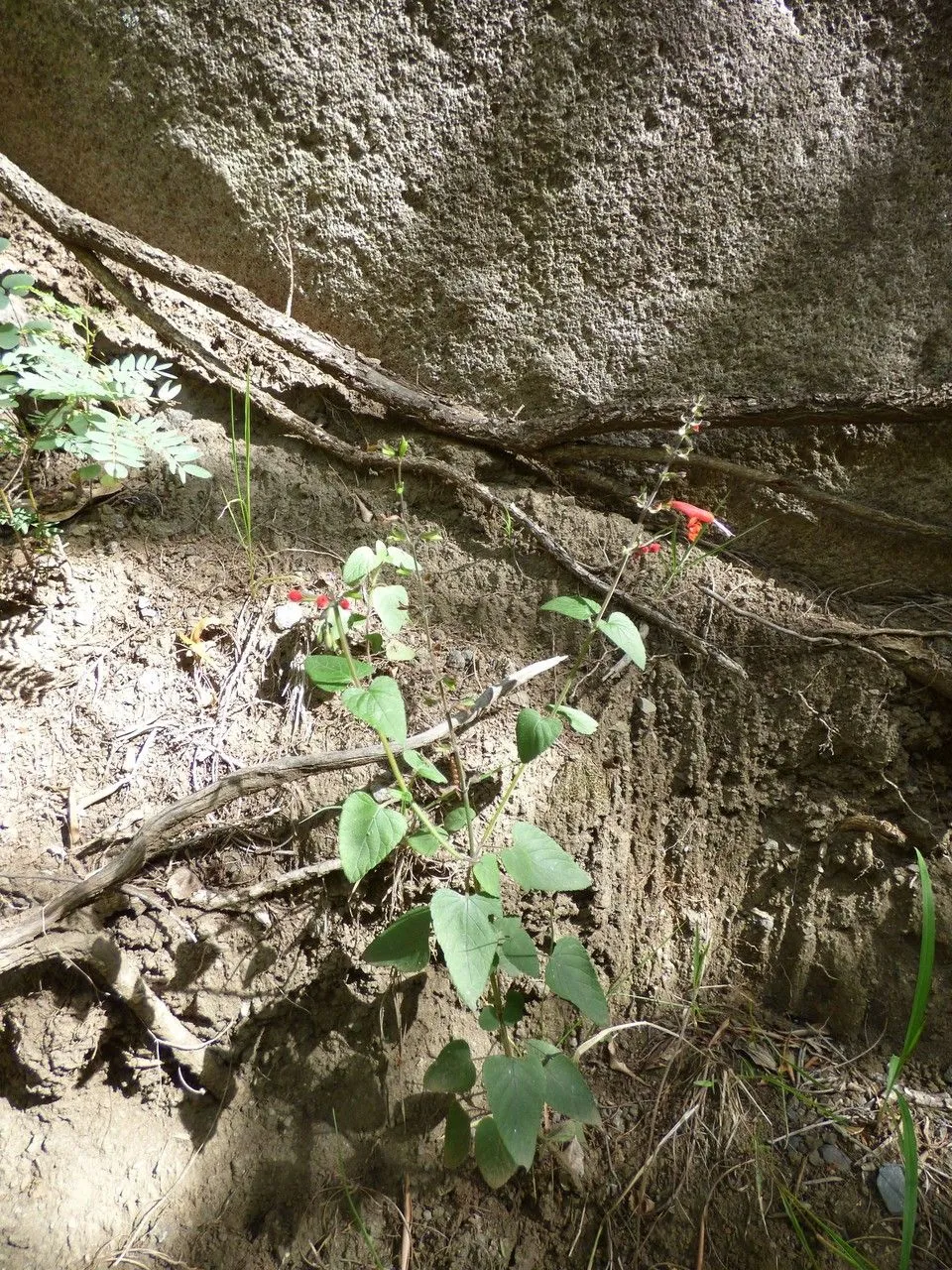
Author: Buc’hoz ex Etl.
Bibliography: Salv.: 23 (1777)
Year: 1777
Status: accepted
Rank: species
Genus: Salvia
Vegetable: False
Observations: SE. U.S.A. to N. Argentina
Texas sage, known scientifically as Salvia coccinea, is a vibrant and attractive plant that belongs to the Lamiaceae family. This species, recognized and documented by Buc’hoz ex Etl. in 1777, is celebrated for its brilliant scarlet red flowers that add a striking splash of color to gardens and natural landscapes.
Native to the Southeastern United States, Texas sage’s range extends all the way to Northern Argentina. This wide distribution is indicative of its adaptability and hardiness in various climates and soil conditions. The plant thrives in both wild settings and cultivated gardens, often found flourishing in meadows, forest edges, and disturbed areas.
Salvia coccinea is a herbaceous perennial that typically reaches heights of about 2 to 3 feet, making it an excellent choice for borders, mass plantings, and pollinator gardens. Its ovate, slightly serrated leaves, which emit a mild aroma when crushed, provide a lush green backdrop to the vivid flowers. The blooms themselves are tubular and arranged in loose, terminal racemes, attracting a host of pollinators, including bees, butterflies, and hummingbirds.
One of the notable features of Texas sage is its long blooming period. From late spring to the first frosts of autumn, the plant produces a continuous display of red blossoms, especially when regularly deadheaded to encourage new growth. This extended flowering season makes it a favorite among gardeners seeking to maintain vibrant, colorful gardens across multiple seasons.
Moreover, Texas sage is known for its low maintenance requirements, which adds to its appeal. It performs well in full sun to partial shade and prefers well-drained soil, though it can tolerate poorer soils and drought conditions once established. This resilience makes it a suitable option for xeriscaping and other water-wise landscape designs.
In addition to its horticultural uses, Salvia coccinea holds cultural significance in certain regions and is occasionally utilized in traditional medicine. Given its enduring beauty and practical benefits, Texas sage continues to be a cherished component of diverse landscapes from the southeastern United States all the way to northern reaches of Argentina.
Eng: blood sage, scarlet sage, texas sage, red salvia, tropical sage, wild salvia
Spa: mirto-coral
Por: sálvia-coral
Fra: sauge écarlate
Swe: scharlakanssalvia
En: Texas sage, Red salvia, Tropical sage, Scarlet sage, Wild salvia, Blood sage, Red sage, Sage, Momili, Cherry Red Sage
Zh: Zhu chun, 朱唇, 紅花鼠尾草
Cs: Šalvěj šarlatová
Fr: Sauge écarlate, Sauge du Texas
De: Scharlachroter Salbei
Ja: Beni-bana-sarubia
Pt: Sálvia-Coral
Sk: Šalvia šarlátová
Es: Škrlatna kadulja, Mirto-coral
Sv: Scharlakanssalvia
Zh-tw: 紅花鼠尾草
To: Teʻekosi
Zh-hant: 朱唇
© copyright of the Board of Trustees of the Royal Botanic Gardens, Kew.
© copyright of the Board of Trustees of the Royal Botanic Gardens, Kew.
© copyright of the Board of Trustees of the Royal Botanic Gardens, Kew.
Taken Oct 18, 2020 by Carmen Villacañas (cc-by-sa)
Taken Oct 8, 2021 by Thierry Thierry Bessière (cc-by-sa)
Taken Oct 5, 2022 by Kai Best (cc-by-sa)
Taken Oct 22, 2017 by Hugo SANTACREU (cc-by-sa)
Taken May 31, 2020 by Jean-Louis BERNARD (cc-by-sa)
Taken Nov 22, 2021 by Boris Camerling (cc-by-sa)
Taken Oct 22, 2017 by Hugo SANTACREU (cc-by-sa)
Taken Oct 5, 2022 by Kai Best (cc-by-sa)
Taken Dec 22, 2021 by Bojan Runtic (cc-by-sa)
Taken Oct 5, 2022 by Kai Best (cc-by-sa)
Taken Apr 9, 2017 by Hugo SANTACREU (cc-by-sa)
Taken Sep 26, 2021 by Jacques Zuber (cc-by-sa)
Taken Sep 3, 2022 by Tristan Jaton-Maria (cc-by-sa)
Taken Apr 9, 2017 by Hugo SANTACREU (cc-by-sa)
Taken Aug 12, 2017 by Tela Botanica − Sylvain PIRY (cc-by-sa)
Taken Sep 13, 2021 by Ling TAN (cc-by-sa)
Taken Sep 2, 2022 by Vicky Floyd (cc-by-sa)
Taken Sep 3, 2022 by Tristan Jaton-Maria (cc-by-sa)
Taken Sep 2, 2022 by Vicky Floyd (cc-by-sa)
Taken Nov 6, 2021 by Veronica Ursula Guzman (cc-by-sa)
Taken Oct 31, 2015 by Tela Botanica − Hugo SANTACREU (cc-by-sa)
Taken Oct 22, 2017 by Hugo SANTACREU (cc-by-sa)
Taken Oct 26, 2019 by Laurie Bates-Frymel (cc-by-sa)
Taken Aug 12, 2017 by Tela Botanica − Sylvain PIRY (cc-by-sa)
Growth habit: Subshrub, Forb/herb
Family: Myrtaceae Author: (F.Muell.) K.D.Hill & L.A.S.Johnson Bibliography: Telopea 6: 402 (1995) Year: 1995 Status:…
Family: Rubiaceae Author: Pierre ex A.Froehner Bibliography: Notizbl. Bot. Gart. Berlin-Dahlem 1: 237 (1897) Year:…
Family: Sapindaceae Author: Koidz. Bibliography: J. Coll. Sci. Imp. Univ. Tokyo 32(1): 38 (1911) Year:…
Family: Asteraceae Author: A.Gray Bibliography: Pacif. Railr. Rep.: 107 (1857) Year: 1857 Status: accepted Rank:…
Family: Fabaceae Author: Medik. Bibliography: Vorles. Churpfälz. Phys.-Ökon. Ges. 2: 398 (1787) Year: 1787 Status:…
Family: Aspleniaceae Author: (Cav.) Alston Bibliography: Bull. Misc. Inform. Kew 1932: 309 (1932) Year: 1932…